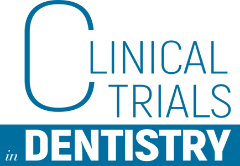Articles
ENDODONTIC RETREATMENT OF TEETH WITH UNCERTAIN ENDODONTIC PROGNOSIS VERSUS DENTAL IMPLANTS: 5-YEAR RESULTS FROM A RANDOMISED CONTROLLED TRIAL
PURPOSE. To ascertain whether it is better to endodontically retreat a previously endodontically treated tooth with periapical pathology and/or symptoms and an uncertain prognosis, or to replace the tooth with a single implant-supported crown.
MATERIALS AND METHODS. Twenty patients requiring treatment of a previously endodontically treated tooth with periapical pathology and/or symptoms of endodontic origin and an uncertain prognosis, as judged by the recruiting investigator, were randomly allocated to endodontic retreatment (endo group; 10 patients) or tooth extraction and replacement with an implant-supported crown (implant group; 10 patients) according to a parallel-group design at a single centre. Patients were followed up to 5 years after treatment completion. Outcome measures were: procedure failure; complications; marginal bone level changes at both teeth and implants; radiographic endodontic success (teeth only);
number of patient visits and days to complete treatment; chairside time; costs; and aesthetics, as assessed using the pink aesthetic score (PES) for the soft tissues and the white aesthetic score (WES) for the tooth/crown by independent assessors.
RESULTS. One patient from the endo group dropped out. One endodontically retreated tooth fractured. There were no statistically significant differences in treatment failure between groups (difference in proportions = 0.1; 95% CI -0.18 to 0.35; P = 1.00). Three endo group patients had one complication each versus one complication in the implant group, the difference not being statistically significant (difference in proportions = 0.2; 95% CI -0.17 to 0.51; P = 0.582). The mean marginal bone levels at endo retreatment/implant insertion were 2.10 ± 0.66 mm for the endo and 0.05 ± 0.15 mm for the implant group. Five years after treatment completion, teeth lost on average 0.60 ± 0.96 mm and implants 0.56 ± 0.77 mm, the difference not being statistically significant (mean difference = -0.05 mm; 95% CI: -0.95 to 0.86; P = 0.914). Of the four teeth that originally showed periapical radiolucency, one was lost, two displayed complete healing, and one showed radiographic improvement. There were no statistically significant differences in the number of patient visits (endo = 6.7 ± 0.7; implant = 6.1 ± 0.7; mean difference = 0.6; 95% CI: -0.1 to 1.3 P = 0.106).
However, it took significantly more days (endo = 61 ± 13.0; implant = 191.4 ± 75.0; mean difference = -130.4; 95% CI: -184.5 to -76.4; P < 0.001) but less chairside time (endo = 628 ± 41.4 min; implant = 328.5 ± 196.4 min; mean difference = -299.5; 95% CI: -441.3 to 1.0; P = < 0.001) to complete the rehabilitation. Implant treatment was significantly more expensive (endo = 1440 ± 549.7; implant = 2099 ± 170.3; mean difference = 659; 95% CI: 257.2 to 1060.8; P = 0.004).
Five years after treatment completion, mean PES were 12.3 ± (1.3) and 8.9 ± 2.2 and mean WES were 8.1 ± 1.4 and 7.1 ± 1.7 in the endo group and implant group, respectively. Soft tissues aesthetics (PES) was significantly better at endodontically retreated teeth (mean difference -3.4; 95% CI -5.1 to -1.6; P (t-test) = 0.001), whereas no significant differences were observed between treatments in tooth aesthetics (WES) (mean difference = -1.0; 95% CI -2.6 to 0.5; P (t-test) = 0.178).
CONCLUSIONS. These results suggest that both endodontic retreatment and replacement of previously endodontically treated teeth with persistant pathology and dubious endodontic prognosis yielded similar medium-term success rates. Soft tissue aesthetics and treatment completion time were better with endodontic retreatment, whereas implant rehabilitation required half the chairside time but was significantly more expensive. Much larger patient populations and longer follow-ups are needed to fully explore this issue, but this study indicated the less invasive endodontic retreatment as the primary therapeutic option.



